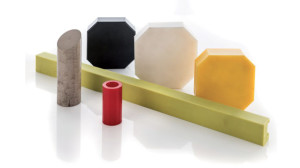
Rods, Sheets, Tubes

Download
Description
Polyamide obtained by the polymerisation of Hexamethylenediamine and Adipic acid. It is one of the oldest engineering plastics, having been created in the USA in 1930. Due to its origin it is widely used in the American and English markets. In comparison to PA6 it is more stiff and tougher but is also more brittle. It is advisable to use PA66 instead of Polyamide 6 when a higher stiffness is required to the detriment of resilience. It can be easily machined on automatic machine tools.
Features
Wear resistance: it is good even in demanding environments
Self-lubricating: the friction coefficient is low and generally for sliding application it does not require lubricators
Toughness: very high tensile stress and compressive strength. Its toughness is higher than that of Polyamide 6
Machining on automatic machine tools is shown to be easy as the shavings break thanks to its higher toughness
Ageing resistance and weatherproof.
Natural colour
Weak Points
It is hygroscopic, even if to a lesser extent than PA6.
It absorbs moisture in time and consequently the mechanical features and the final dimensions will change.
Application
Mechanical: because it has a higher stiffness than PA6 it is used for mechanical applications when this feature is more important than that of shock resistance: suitable for gears, cams, pulleys, anti-wear guides, wheels and mechanical parts. Like Akulon GX, it machines very easily on automatic tools
Food contact: in some cases it can be used in contact with food
Electrical: use in the electrical field is to be avoided as the electrical features change with the moisture content
Chemical: it is resistant to alkali, inorganic compounds and solvents